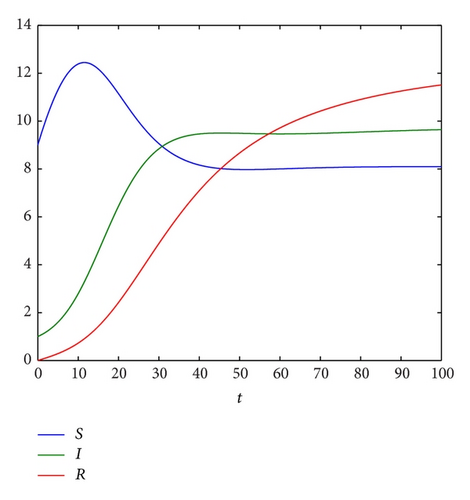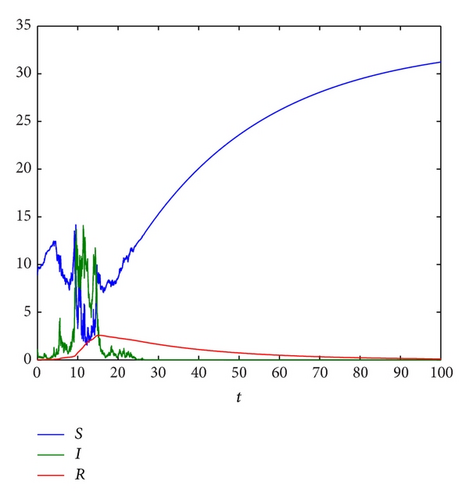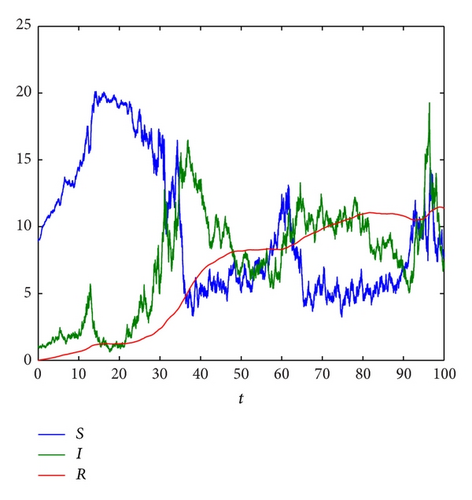Stochastic Extinction in an SIRS Epidemic Model Incorporating Media Coverage
Abstract
We extend the classical SIRS epidemic model incorporating media coverage from a deterministic framework to a stochastic differential equation (SDE) and focus on how environmental fluctuations of the contact coefficient affect the extinction of the disease. We give the conditions of existence of unique positive solution and the stochastic extinction of the SDE model and discuss the exponential p-stability and global stability of the SDE model. One of the most interesting findings is that if the intensity of noise is large, then the disease is prone to extinction, which can provide us with some useful control strategies to regulate disease dynamics.
1. Introduction
Recent years, a number of mathematical models have been formulated to describe the impact of media coverage on the dynamics of infectious diseases [1–10]. Mass media (television, radio, newspapers, billboards, and booklets) has been used as a way of delivering preventive health messages as it has the potential to influence people’s behavior and deter them from risky behavior or from taking precautionary measures in relation to a disease outbreak [7, 11, 12]. Hence, media coverage has an enormous impact on the spread and control of infectious diseases [2, 3, 9].
On the other hand, for human disease, the nature of epidemic growth and spread is inherently random due to the unpredictability of person-to-person contacts [13], and population is subject to a continuous spectrum of disturbances [14, 15]. In epidemic dynamics, stochastic differential equation (SDE) models could be the more appropriate way of modeling epidemics in many circumstances and many realistic stochastic epidemic models can be derived based on their deterministic formulations [16–28].
In [10], Liu investigated an SIRS epidemic model incorporating media coverage with random perturbation. He assumed that stochastic perturbations were of white noise type, which were directly proportional to distance susceptible S(t), infectious I(t), and recover R(t) from values of endemic equilibrium point (S*, I*, R*), influence on the dS(t)/dt, dI(t)/dt, dR(t)/dt, respectively. In fact, besides the possible equilibrium approach in [10], there are different possible approaches to introduce random effects in the epidemic models affected by environmental white noise from biological significance and mathematical perspective [28–30]. Some scholars [17, 28, 30, 31] demonstrated that one or more system parameter(s) can be perturbed stochastically with white noise term to derive environmentally perturbed system.
In [10], the author proved that the endemic equilibrium of the stochastic model is asymptotically stable in the large. Therefore, it is natural to ask how environmental fluctuations of the contact coefficient affect the extinction of the disease.
In this paper, we will focus on the effects of environmental fluctuations on the disease’s extinction through studying the stochastic dynamics of an SIRS model incorporating media coverage. The rest of this paper is organized as follows. In Section 2, based on the results of Cui et al. [2] and [10], we derive the stochastic differential SIRS model incorporating media coverage. In Section 3, we give the conditions of existence of unique positive solution and the stochastic extinction of the SDE model. In Section 4, we provide some examples to support our research results. In the last section, we provide a brief discussion and the summary of main results.
2. Model Derivation and Related Definitions
2.1. Model Derivation
Obviously, the stochastic model (3) has the same disease-free equilibrium E0 = (Λ/μ, 0,0) as model (1).
2.2. Related Definitions
Let us first recall a few definitions.
Definition 1 (see [32].)The trivial solution x(t) = 0 of (5) is said to be
- (i)
stable in probability if, for all ɛ > 0,
(6) - (ii)
asymptotically stable if it is stable in probability and moreover if
(7) - (iii)
globally asymptotically stable if it is stable in probability and moreover if, for all x0 ∈ ℝn
(8) - (iv)
almost surely exponentially stable if for all x0 ∈ ℝn,
(9) - (v)
exponentially p-stable if there is a pair of positive constants C1 and C2 such that for all x0 ∈ ℝn,
(10)
3. Dynamics of the SDE Model (3)
In what follows, we first use the method of Lyapunov functions to find conditions of existence of unique positive solution of model (3).
3.1. Existence of Unique Positive Solution of Model (3)
In this subsection, we show the existence of the unique positive global solution of SDE model (3).
Theorem 2. Consider model (3), for any given initial value (S(0), I(0), R(0)) ∈ Γ; then there is a unique solution (S(t), I(t), R(t)) on t ≥ 0 and it will remain in with probability one.
Proof. The proof is almost identical to Theorem 2 of [33], but for completeness we repeat it here. Let (S(0), I(0), R(0)) ∈ Γ. Summing up the three equations in (3) and denoting N(t) = S(t) + I(t) + R(t), we have
Since the coefficients of model (3) satisfy the local Lipschitz condition, there is a unique local solution on [0, τe), where τe is the explosion time. Therefore, the unique local solution to model (3) is positive by the Itô’s formula. Now, let us show that this solution is global; that is, τe = ∞ a.s.
Let ϵ0 > 0 such that S(0), I(0), R(0) > ϵ0. For ϵ ≤ ϵ0, define the stop-times
Define a C2-function by
On the other hand, in view of (14), we have V(S(t∧τϵ), I(t∧τϵ), R(t∧τϵ)) > 0. It then follows that
From Theorem 2 and (14), we can conclude the following corollary.
Corollary 3. The set Γ is almost surely positive invariant of model (3); that is, if (S(0), I(0), R(0)) ∈ Γ, then ℙ((S(t), I(t), R(t)) ∈ Γ) = 1 for all t ≥ 0.
3.2. Stochastic Extinction of Model (3)
In this subsection, we investigate stochastic stability of the disease-free equilibrium E0 = (Λ/μ, 0,0) in almost sure exponential and exponential p stability by using the suitable Lyapunov function and other techniques of stochastic analysis.
The following theorem gives a sufficient condition for the almost surely exponential stability of the disease-free equilibrium E0 = (Λ/μ, 0,0) of model (3).
Theorem 4 (almost sure exponential stability). If , then disease-free E0 = (Λ/μ, 0,0) of model (3) is almost surely exponentially stable in Γ.
Proof. Define a function V by
We now consider the concept of exponential p-stability. The following lemma gives sufficient conditions for exponential p-stability of stochastic systems in terms of the Lyapunov functions (see [32]).
Lemma 5 (see [32].)Suppose that there exists a function V(z, t) ∈ C2(Ω) satisfying the following inequalities:
From the above Lemma, we obtain the following theorem.
Theorem 6 (exponential p-stability). Let p ≥ 2. If the conditions R0 = β1Λ/μ(μ + α + λ) < 1 and hold, the disease-free equilibrium E0 = (Λ/μ, 0,0) of model (3) is pth moment exponentially stable in Γ.
Proof. Let p ≥ 2 and (S(0), I(0), R(0)) ∈ Γ; in view of Corollary 3, the solution of model (3) remains in Γ. We define the Lyapunov function V(S, I, R) as follows:
Furthermore, by the Itô’s formula, it follows from S, I, R ∈ (0, Λ/μ) that
Under Lemma 5 and Theorems 6, we have in the case p = 2 the following corollary.
Corollary 7 (globally asymptotically stable). If the conditions R0 = β1Λ/μ(μ + α + λ) < 1 and hold, the disease-free equilibrium E0 = (Λ/μ, 0,0) of model (3) is globally asymptotically stable in Γ.
4. Numerical Simulations and Dynamics Comparison
(1) The Endemic Dynamics of the Deterministic Model (1). For the deterministic model (1), R0 = β1Λ/μ(μ + α + λ) = 7.407 > 1; thus, it admits a unique endemic equilibrium E* = (8.1035,9.7664,12.2080) which is globally stable for any initial values (S(0), I(0), R(0)) ∈ Γ according to [10] (see, Figure 1).

(2) The Stochastic Dynamics of Model (3). For the corresponding stochastic model (3), we choose σ = 0.1; then, we have . Thus, from Theorem 4, we can conclude that for any initial value (S(0), I(0), R(0)) ∈ Γ, disease-free E0 = (Λ/μ, 0,0) of model (3) is almost surely exponentially stable in Γ (see Figure 2(a)).


To see the disease dynamics of model (3) more, we decrease the noise intensity σ to be 0.02 and keep the other parameters unchanged. Then, we have . Therefore, the condition of Theorem 4 is not satisfied. In this case, our simulations suggest that model (3) is stochastically persistent (see Figure 2(b)).
5. Concluding Remarks
In this paper, we propose an SIRS epidemic model with media coverage and environment fluctuations to describe disease transmission. It is shown that the magnitude of environmental fluctuations will have an effective impact on the control and spread of infectious diseases. In a nutshell, we summarize our main findings as well as their related biological implications as follows.
Theorem 4 and [10] combined with numerical simulations (see Figures 1 and 2) provide us with a full picture on the dynamics of the deterministic model (1) and stochastic model (3). In [10], the authors showed that the deterministic model (1) admits a unique endemic equilibrium E* which is globally asymptotically stable if its basic reproduction number R0 > 1 (see Figure 1). If the magnitude of the intensity of noise σ is large, that is, , the extinction of disease in the stochastic model (3) occurs whether R0 is greater than 1 or less than 1 (see Figure 2(a)). While the magnitude of the intensity of noise σ is small, one of our most interesting findings is that disease may persist if R0 > 1, (see Figure 2(b)).
Needless to say, both equilibrium possible approach and parameter possible approach in the present paper have their important roles to play. Obviously, our results in the present paper may be a useful supplement for [10].
Conflict of Interests
The authors declare that there is no conflict of interests regarding the publication of this paper.
Acknowledgments
This research was supported by the National Science Foundation of China (61373005, 11201344, and 11201345) and Zhejiang Provincial Natural Science Foundation (LY12A01014).




